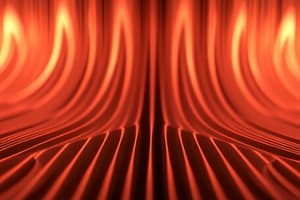Podcast
Questions and Answers
Which phenomenon describes the overlap of two or more light waves, resulting in a new wave pattern?
Which phenomenon describes the overlap of two or more light waves, resulting in a new wave pattern?
- Interference (correct)
- Diffraction
- Refraction
- Polarization
In Young’s Double Slit Experiment, the pattern of bright and dark fringes is primarily due to which principle?
In Young’s Double Slit Experiment, the pattern of bright and dark fringes is primarily due to which principle?
- Principle of Superposition of Waves (correct)
- Principle of Geometric Optics
- Principle of Quantum Mechanics
- Principle of Conservation of Energy
What type of light source is required to produce coherent light for experiments like the Michelson Interferometer?
What type of light source is required to produce coherent light for experiments like the Michelson Interferometer?
- A standard incandescent bulb
- A prism
- A laser (correct)
- A fluorescent lamp
What occurs during a phase change on reflection when light reflects off a medium with a higher refractive index?
What occurs during a phase change on reflection when light reflects off a medium with a higher refractive index?
What is the primary application of the Fabry-Perot Interferometer?
What is the primary application of the Fabry-Perot Interferometer?
Flashcards are hidden until you start studying
Study Notes
Wave Optics
- Wave Optics is a branch of optics that studies the wave-like nature of light.
- Wave optics phenomena include Interference, Diffraction, Polarization, and Lasers.
Interference
- Interference occurs when two or more waves superpose.
- Superposition principle states that the resultant displacement at any point is the vector sum of the displacements due to individual waves.
- Coherent light is required for producing interference patterns.
- Coherent light sources emit waves with a constant phase difference between them.
- There are two methods for producing coherent light: Division of Wavefront and Division of Amplitude.
Young's Double Slit Experiment
- Young's experiment demonstrates the wave nature of light and provides a method for measuring the wavelength of light.
- Interference pattern consists of alternating bright and dark fringes, with bright fringes occurring where the path difference between the two waves is an integral multiple of the wavelength and dark fringes occurring where the path difference is an odd multiple of half the wavelength.
Phase Change on Reflection
- When light reflects from a denser medium, a phase change of 180 degrees occurs.
- When light reflects from a rarer medium, no phase change occurs.
Thin Film Interference
- Thin film interference occurs when light is reflected from the two surfaces of a thin film.
- Interference patterns are observed due to the path difference between the reflected waves from the two surfaces.
Michelson Interferometer
- Michelson interferometer utilizes interference to measure the wavelength of light, refractive index of a medium, and the distance between two mirrors.
- It consists of two mirrors at right angles to each other and a beam splitter that divides the incident beam into two beams.
- The two beams are reflected back to the beam splitter, where they interfere.
Fabry-Perot Interferometer
- Fabry-Perot interferometer consists of two parallel plates separated by a small distance.
- It is used to measure the wavelength of light and resolve closely spaced spectral lines.
Applications of Interference Filters
- Interference filters are used to select specific wavelengths of light and are used in various applications, including optical instruments, photography, and spectroscopy.
Studying That Suits You
Use AI to generate personalized quizzes and flashcards to suit your learning preferences.



